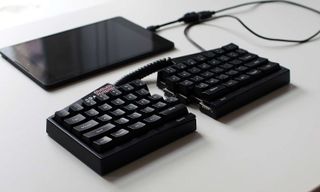Ultimate Hacking Keyboard Splits In Half
The ultimate hacking keyboard has no numpad, no function keys and no problem splitting in half to provide a more comfortable conformation.
I've reviewed some unusual keyboards in my time, but the Ultimate Hacking Keyboard from Ultimate Gadget Laboratories is one of the strangest I've seen. This minimalist keyboard has no number pad, no arrow keys, no scroll keys, no function keys — and no problem literally splitting in half to provide a more comfortable conformation.
The Ultimate Hacking Keyboard has just begun a crowdfunding effort, so users can decide for themselves whether this is something for which they'd be willing to shell out big bucks.
MORE: Top Picks for Gaming Keyboards
I met with László Monda, the Hungarian creator of the Ultimate Hacking Keyboard, who walked me through some of its features and its raison d'être. Monda is a developer and programmer himself, and realized that standard keyboards are simply not designed with programming efficiency in mind.
The average keyboard contains more than 100 keys, and as such, has to maintain a flat, rectangular shape to fit them all. By eliminating all the extraneous keys, Monda reasoned he could come up with something more comfortable.
As such, the Ultimate Hacking Keyboard features mostly alphanumeric keys along with a handful of simple control options, such as Enter, Shift, Tab and a button that shifts the keyboard into a Mouse mode. If typing on a flat, straight surface isn't comfortable, you can split the keyboard into two pieces along the TGB/YHN axis and get your fingers into a more natural position.
The two halves connect with an ordinary spiraling telephone wire. (If you were born after 1990, that's something we old folks used to connect telephone handsets to the telephone bases back in the landline caveman days.)
Sign up to get the BEST of Tom's Guide direct to your inbox.
Get instant access to breaking news, the hottest reviews, great deals and helpful tips.

Programmers and developers are the Ultimate Hacking Keyboard's primary target audience, but not necessarily its only one. Monda explained that everyday typists who want maximum comfort, as well as some gamers, may be interested in the keyboard's design. After all, games and everyday typing don't require much in the way of extra keys, either.
However, programmers, developers, typists and gamers alike all need extra keys at some point, and the Ultimate Hacking Keyboard provides a back door. Thanks to three extra buttons on the keyboard, users can switch among different keymaps, which can transform, say, the 1 button into F1, the 2 button into F2, and so forth. Each key is fully programmable, and each profile can support up to four keymaps, so accessing all the buttons you need without lifting your hands is an extremely feasible proposition.
Furthermore, if four keymaps isn't enough, the keyboard will also come with software that lets users create and save additional profiles. The keyboard and software work with Windows, Mac, Linux and Android systems, although iOS is out of the question for the moment, simply because it doesn't accept USB input.
In terms of key types, the Ultimate Hacking Keyboard is completely mechanical, and will offer a choice between standard Blue, Brown and Red switches, as well as more obscure Black, Clear and Green ones. Each switch type offers a difference in terms of resistance and clackety noises, but sadly, none will be authentic Cherry MX switches. Ultimate Gadget Laboratories has opted to go with Chinese brands like Greetech instead.
The more specialized a peripheral gets, the more it costs, and the Ultimate Hacking Keyboard is no exception. Monda is aiming to raise $200,000 on Crowd Supply, with stretch goals for items such as wrist rests in case the keyboard proves extremely popular. A super-early-bird special promises users a keyboard for $200, assuming the project reaches completion. Later investors can pick one up for $220, and it will retail for $250 upon its (projected) release in the second half of 2016.
It's worth noting, as well, that the Ultimate Hacking Keyboard is not the first peripheral to split into unusual configurations. Keyboardio has a very similar configuration, and other companies from Kinesis to Microsoft have toyed around with nonstandard keyboard shapes in order to improve the ergonomic feel.
The Ultimate Hacking Keyboard has been making swift crowdfunding progress so far, but only the next 60 days will tell whether it reaches its $200,000 goal, falls short of it or exceeds it. If the product makes it to market, we may give it a go and see how it stacks up to the competition.
Marshall Honorof is a senior editor for Tom's Guide, overseeing the site's coverage of gaming hardware and software. He comes from a science writing background, having studied paleomammalogy, biological anthropology, and the history of science and technology. After hours, you can find him practicing taekwondo or doing deep dives on classic sci-fi.
